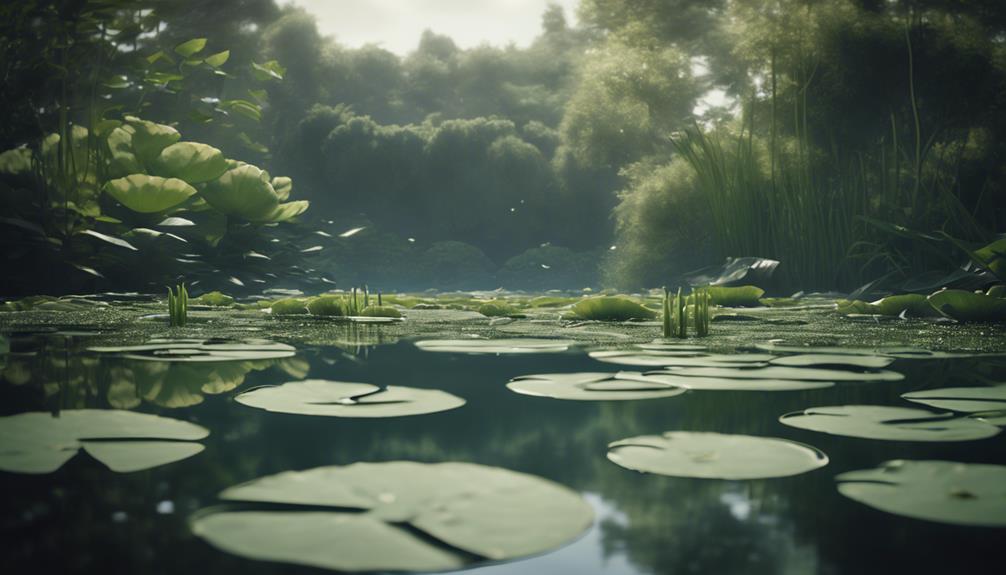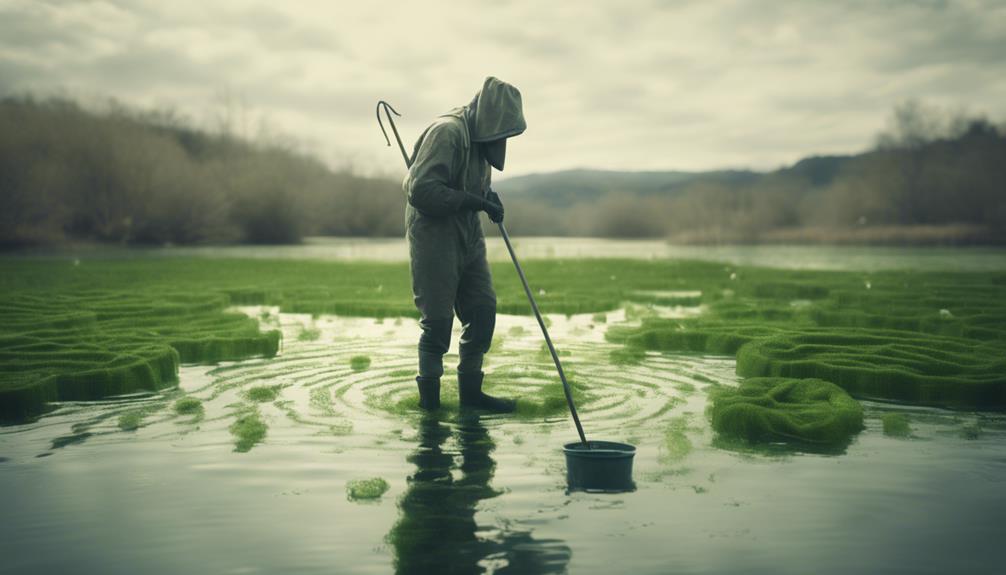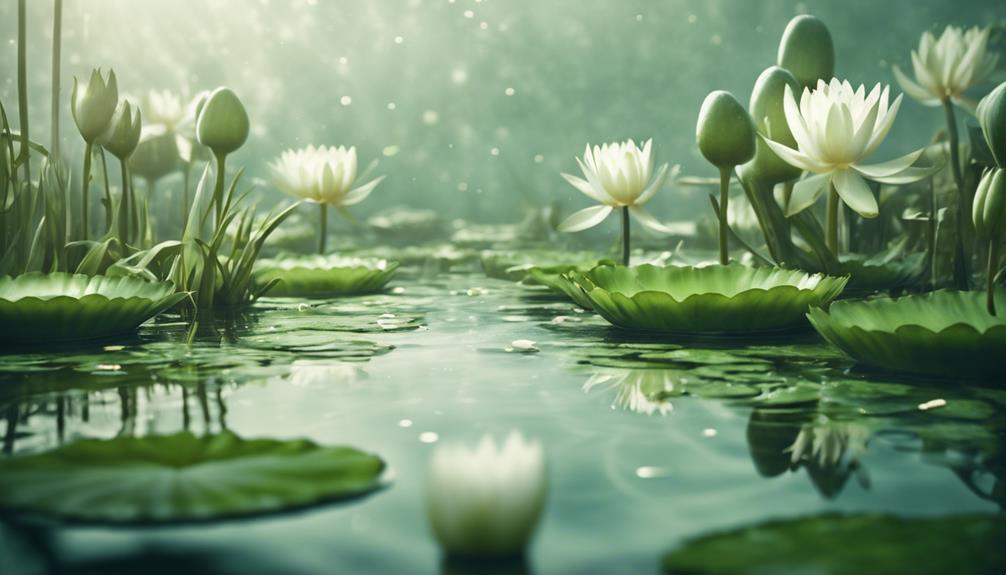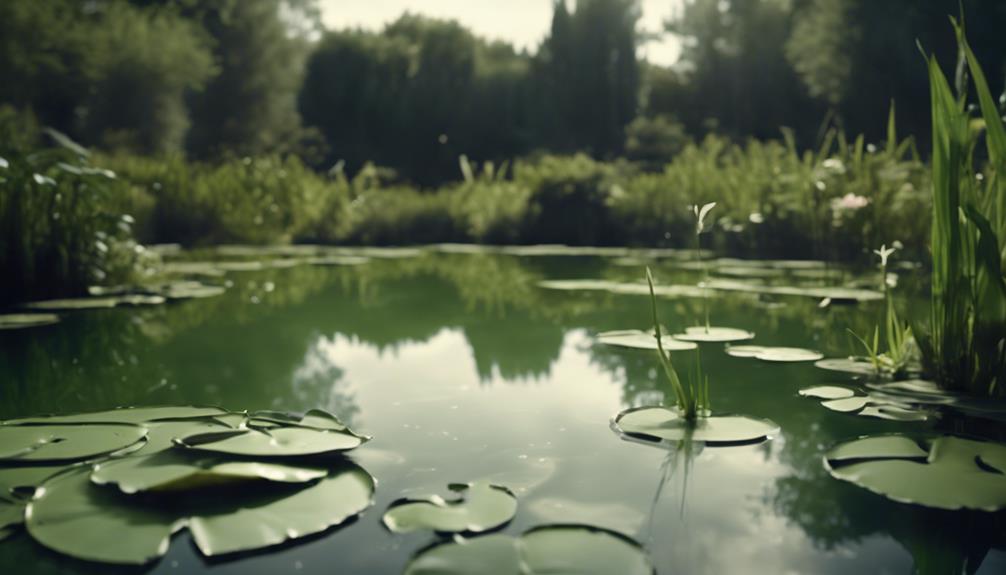When you're dealing with a pond algae bloom, crucial to address the underlying causes of excess nutrients, particularly phosphorus and nitrogen, to restore balance to the ecosystem. Natural methods can effectively remove algae fast. You can introduce aquatic plants like water lilies and lotuses to compete with algae for nutrients, or use beneficial bacteria to break down organic matter and recycle nutrients. Barley straw and algae-eating species like grass carp and Nerite snails can also help control algae populations. By combining these methods, you'll be on your way to a balanced ecosystem where algae growth is naturally regulated, and you'll discover even more ways to maintain a thriving pond environment.
Table of Contents
Key Takeaways
- Introduce beneficial bacteria to break down organic matter, reducing nutrients available for algae growth and converting dead plants and waste into harmless substances.
- Add aquatic plants like water lilies and lotuses to absorb excess nutrients, provide shade, and compete with algae for resources.
- Use barley straw to release compounds that inhibit algae growth, providing a gradual and long-lasting control method.
- Introduce algae-eating species like grass carp and Nerite snails to naturally control and reduce algae populations.
- Implement aeration methods like waterfalls, fountains, or air stones to increase oxygen levels, promoting aerobic bacteria and breaking down organic matter efficiently.
Understanding Algae Growth Causes
Excessive nutrient availability, particularly phosphorus and nitrogen, fuels algae growth in your pond, creating an ideal environment for these microorganisms to thrive.
You might be wondering, where do these excess nutrients come from? The answer lies in the organic matter that enters your pond, such as decaying plants, fish waste, and runoff from surrounding soil.
As these organic materials break down, they release nutrients into the water, providing a constant supply for algae growth. This excess of nutrients disrupts the ecological balance of your pond, compromising water quality and paving the way for algae blooms.
Crucial to recognize is that algae growth is a symptom of a larger issue – an imbalance in your pond's ecosystem. By addressing the cause of algae, you can restore the delicate balance of your pond's environment.
Natural Remedies for Pond Algae
To combat the underlying issue of excessive nutrient availability, you can employ natural remedies that target algae growth, including introducing specific aquatic plants, beneficial bacteria, and algae-eating species to your pond.
These natural remedies can help control algae and maintain a healthy, balanced ecosystem.
For instance, aquatic plants like water lilies and lotuses provide shade, reducing direct sunlight and hindering algae growth, while also competing with algae for nutrients.
Beneficial bacteria, on the other hand, break down organic matter, reducing nutrients available for algae growth and converting dead plants, fish waste, and other debris into less harmful substances.
Barley straw is another natural remedy that releases compounds that inhibit algae growth, providing a gradual and long-lasting control method.
Additionally, introducing algae-eating species, such as grass carp and Nerite snails, can help naturally control and reduce algae populations.
How Plants Control Algae Growth

By incorporating specific aquatic plants into your pond, you can harness their natural ability to suppress algae growth, creating a more balanced ecosystem.
Pond plants, such as Water lilies, play a vital role in controlling algae in ponds. They consume algae as a source of nutrients, reducing the likelihood of algae overgrowth. Additionally, these plants absorb excess nutrients from the water, making it harder for algae to thrive.
As you introduce more plants and algae-fighting species to your pond, you'll notice a significant decrease in algae growth. This harmonious relationship between plants and algae is essential for maintaining a healthy pond environment.
By choosing the right aquatic plants, you can create a natural barrier against algae growth, reducing the need for chemical treatments and maintaining a thriving ecosystem. So, take advantage of nature's solution and let pond plants do the work for you.
With the right plants, you'll be enjoying a clear and balanced pond in no time.
Aeration for Balanced Ecosystem
As you work to remove pond algae, you'll want to focus on creating an oxygen-rich environment that supports the growth of beneficial aerobic bacteria.
These microorganisms are essential for breaking down organic matter, which can fuel algae growth if left unchecked.
Aerobic Bacteria Breakdown
While maintaining a balanced ecosystem, you'll find that aerobic bacteria play a pivotal role in breaking down organic matter and consuming excess nutrients, ultimately preventing algae overgrowth.
These microorganisms thrive in oxygen-rich environments, which allows them to outcompete algae for resources.
By promoting the health of aerobic bacteria, you're safeguarding a balanced ecosystem where they can convert ammonia and nitrite into harmless compounds, reducing the availability of nutrients for algae growth.
To create an environment conducive to aerobic bacteria growth, you can use aeration methods such as waterfalls, fountains, air stones, and windmills.
These methods increase oxygen levels in the water, allowing aerobic bacteria to flourish.
As a result, they'll break down organic matter more efficiently, controlling pond algae and maintaining healthy water.
Regular aeration maintenance is essential to safeguard the continued health and effectiveness of aerobic bacteria in controlling algae populations.
Oxygen Rich Water Flow
You can maintain a balanced ecosystem by creating oxygen-rich water flow, which is essential for aerobic bacteria to thrive and outcompete algae for resources.
In oxygen-rich environments, aerobic bacteria break down organic matter efficiently, preventing algae overgrowth and maintaining a balanced ecosystem.
To achieve this, you can implement aeration methods such as waterfalls, fountains, air stones, or windmills, which increase oxygen levels and improve water circulation.
This creates an environment where algae struggle to thrive.
Adequate aeration helps maintain a healthy balance of dissolved oxygen, with levels above 5 mg/L ideal for supporting beneficial bacteria and suppressing algae growth.
By incorporating aeration methods, you can guarantee your pond has sufficient oxygen levels, promoting a thriving ecosystem.
Remember, in ponds with inadequate aeration, algae can grow rapidly, depleting oxygen and creating an environment conducive to anaerobic bacteria, which can harm aquatic life.
Beneficial Bacteria for Algae Control

Beneficial bacteria, such as those in the genus Bacillus, play a crucial role in algae control by breaking down organic matter and recycling nutrients, thereby depriving algae of the resources it needs to thrive.
As you introduce these beneficial bacteria into your pond ecosystem, they'll get to work, converting nitrate and phosphate into harmless compounds that won't fuel algae growth. This natural process reduces oxygen depletion, a common issue in ponds plagued by algae blooms.
You'll notice a significant decrease in algae growth as these beneficial bacteria do their job. By incorporating beneficial bacteria into your algae control methods, you're taking a proactive approach to maintaining a balanced pond ecosystem.
Unlike manual removal, which only provides temporary relief, beneficial bacteria provide a long-term solution. As you create a healthy environment for these beneficial bacteria to thrive, you'll enjoy a clearer, healthier pond that's less prone to algae issues.
Barley Straw and Algae-Eating Fish
In addition to beneficial bacteria, two more natural methods for removing pond algae are the use of barley straw and the introduction of algae-eating fish and invertebrates.
You can harness the power of barley straw to control algae blooms in your pond. When decomposing, barley straw releases compounds that inhibit algae growth, providing a gradual and long-lasting control method. To use it effectively, place the barley straw in a mesh bag and anchor it where water flows over it for optimum results.
Another approach is to introduce algae-eating fish, like the grass carp, which feed on algae, providing a natural way to control and reduce algae populations. However, be mindful of the compatibility of these fish with other pond inhabitants and the ecological balance of your Clear Pond.
You can also consider introducing nerite snails, another example of algae-eating species, to naturally control algae populations. By incorporating these natural methods, you'll be well on your way to maintaining a healthy and balanced pond ecosystem.
Manual Removal and Ongoing Efforts

Manual removal of algae, a straightforward and immediate solution, involves physically skimming or raking out the unwanted growth from the pond's surface, providing a quick fix for pesky algae blooms. This method is especially effective for ponds prone to regular algae outbreaks. To enhance the effectiveness of manual removal, consider introducing beneficial bacteria to your pond. These microorganisms convert dead plants, fish waste, and other organic debris into less harmful substances, reducing the nutrients available for algae growth.
| Method | Effectiveness |
|---|---|
| Manual Removal | Immediate results, but may require periodic skimming |
| Beneficial Bacteria | Reduces nutrients available for algae growth |
| Combination | Powerful one-two punch against algae growth |
Limiting Nutrient Sources and Sunlight
You can further prevent algae growth by addressing the underlying factors that contribute to its development, namely the excessive nutrients and sunlight that fuel its proliferation.
To reduce the nutrients available to algae, you can implement measures to limit the amount of fertilizer runoff, animal waste, and decaying organic matter that enter your pond. Algae need these nutrients to thrive, so reducing their availability will naturally limit algae growth.
Additionally, you can take steps to reduce the amount of sunlight that reaches your pond's surface, as algae rely on sunlight to fuel their growth. Consider installing a shade-providing structure or adding plants that absorb excess nutrients, such as aquatic plants and bacteria.
Maintaining a Balanced Pond Ecosystem

As you take steps to limit nutrient sources and sunlight, you'll want to focus on maintaining a balanced pond ecosystem, where healthy aquatic plants and microorganisms thrive.
This balance is vital, as it allows natural processes to regulate algae growth, reducing the need for chemical treatments.
Healthy Ecosystem Balance
How do subtle changes in nutrient levels impact the delicate balance of your pond's ecosystem? Even slight variations can have a ripple effect, leading to an unhealthy environment for aquatic life. Maintaining a healthy ecosystem balance is vital for pond maintenance, as it prevents the growth of unwanted algae.
| Ecosystem Imbalance | Consequences |
|---|---|
| Excess nutrients | Algae blooms, depleting oxygen for aquatic life |
| Insufficient oxygen | Stressed or dying aquatic life, increased algae growth |
| pH level fluctuations | Disrupted nutrient cycles, affecting aquatic life |
| Inadequate water circulation | Stagnant water, perfect for algae growth |
A healthy ecosystem balance is essential for a thriving environment. By understanding the interconnectedness of your pond's ecosystem, you can take proactive steps to maintain a balanced environment. This, in turn, helps to prevent algae growth naturally. Algae Naturally, a balanced ecosystem is the key to a thriving pond, where aquatic life flourishes and unwanted algae is kept at bay. By adopting a holistic approach to pond maintenance, you can create a harmonious environment that benefits all aspects of your pond's ecosystem.
Natural Algae Control
By adopting a multifaceted approach that incorporates plant life, beneficial microorganisms, and aeration, pond owners can effectively create an environment that suppresses algae growth and promotes a balanced ecosystem.
You can help keep your pond cleaner and more environmentally friendly by introducing natural methods to control algae.
A balanced pond ecosystem plays a crucial role in preventing algae growth, and it's achievable by maintaining a healthy mix of plants, fish, and bacteria.
Plants consume the same nutrients as algae, while beneficial bacteria break down organic matter and consume excess nutrients.
Introducing algae-eating fish and snails, such as grass carp and Nerite snails, can also provide a natural way to control and reduce algae populations.
To rid of algae, regular monitoring of water quality parameters is imperative and address any imbalances that could lead to algae growth.
Frequently Asked Questions
What Kills Algae Immediately?
You're looking for a quick fix to kill algae immediately. Unfortunately, there's no natural method that does so. Instead, consider using algae burners, oxygen boosters, UV clarifiers, or copper sulfate, but be aware that these methods can have unintended consequences on your pond's ecosystem.
How to Clear Green Pond Water Fast Naturally?
You're drowning in a sea of green, with algae blooms suffocating your pond's aquatic life! Boost oxygen levels with pond aeration and water circulation, sparking natural filtration that clears the green water, reviving your pond's ecosystem.
Does Vinegar Kill Algae in Ponds?
You're wondering if vinegar kills algae in ponds. Research shows it can, but it's vital to get the vinegar dosage right, as excessive acidity can harm aquatic life, and algae may develop resistance in acidic environments.
How to Remove Algae From Water Plants Naturally?
You can remove algae from water plants naturally by introducing algae-eating organisms, beneficial bacteria, and natural filters, while ensuring aquatic plants receive adequate plant nutrients, and maintaining ideal water circulation to achieve ecosystem balance.
Conclusion
As you gaze out at your once-pristine pond, now choked by unsightly algae, remember that balance is key.
By harnessing nature's arsenal – from plants to beneficial bacteria – you can vanquish this aquatic nemesis.
With patience and persistence, your pond will transform, its crystal-clear waters reflecting the beauty of a thriving ecosystem.
Like a symphony conductor, you'll orchestrate harmony, and your pond will sing with vibrancy, free from the suffocating grip of algae.

